Recommendation of Heinrich Tilesius, the Rector of the Tilsit Provincial School, to His Pupil Johann Schultz
Abstract
The article discusses and presents, along with its translation into Lithuanian and commentaries, a document kept at the Secret State Archives Prussian Cultural Heritage Foundation (Ger. Geheimes Staatsarchiv Preußischer Kulturbesitz) in Berlin (shelf mark: GStA PK: I. HA GR, Rep. 7 Preußen, No. 191 [1685–1703]). It is a copy of the recommendation written on 30 April 1695 by Heinrich Tilesius (1666–1732), the rector of the Tilsit provincial school, to the pupil Johann Schultz (Jonas Šulcas, ~1678–1709), a future theology student at the University of Königsberg, a priest in Prussian Lithuania, and the translator of the first Lithuanian book of literary fiction, Die Fabeln Aesopi (Aesop’s Fables, Königsberg, 1706). Tilesius’s recommendation is important for several reasons.
This archival source provides information about the Tilsit provincial school: the name of Johann Schultz extends the list of the school’s well-known pupils, evidences the most important subjects included in the curriculum of the time, and reveals some of the competences of the schoolmaster.
Tilesius’s Latin text is an example of a recommendation written in a high or almost Ciceronian style of eloquence; it is a distinctive rhetorical piece demonstrating the excellent classical education of the rector of the provincial school of Tilsit.
The recommendation also adds new details to the biographical information on Johann Schultz, the pupil of this school, a future creator of Lithuanian literature, or, more precisely, provides some facts about his education prior to his studies at the University of Königsberg: not only did he go to the provincial school in Tilsit, but he also attended the Latin school in Insterburg, where, besides learning Latin, he also studied Greek and acquired knowledge of poetry, philosophy, and, in particular, rhetoric. Schultz’s teachers included not only Heinrich Tilesius, but also Johann Picker (~1640–1693), a well-known pedagogue of the time, a follower of Philipp Jacob Spener (1635–1705) and a promoter of his ideas in Prussia.

This work is licensed under a Creative Commons Attribution 4.0 International License.
Most read articles by the same author(s)
- Ona Aleknavičienė, Liucija Citavičiūtė, Mintautas Čiurinskas, Simona Jaskelevičiūtė, Birutė Triškaitė, Chronicle , Senoji Lietuvos literatūra: Vol. 42 (2016): Senoji Lietuvos literatūra
- Ona Dilytė-Čiurinskienė, Mintautas Čiurinskas, Živilė Nedzinskaitė, Annotations , Senoji Lietuvos literatūra: Vol. 50 (2020): Senoji Lietuvos literatūra
- Darius Antanavičius, Liucija Citavičiūtė, Ona Dilytė-Čiurinskienė, Živilė Nedzinskaitė, Žavinta Sidabraitė, Annotations , Senoji Lietuvos literatūra: Vol. 49 (2020): Senoji Lietuvos literatūra
- Ona Aleknavičienė, Liucija Citavičiūtė, Mintautas Čiurinskas, Birutė Triškaitė, Chronicle , Senoji Lietuvos literatūra: Vol. 41 (2016): Senoji Lietuvos literatūra
- Birutė Triškaitė, Jonas Šulcas, Translator of Aesop’s Fables: Traces of His Biography , Senoji Lietuvos literatūra: Vol. 53 (2022): Senoji Lietuvos literatūra
- Ona Dilytė-Čiurinskienė, Editorial Board and Table of Contents , Senoji Lietuvos literatūra: Vol. 57 (2024): Senoji Lietuvos literatūra
- Ona Dilytė-Čiurinskienė, Darius Kuolys, Annotations , Senoji Lietuvos literatūra: Vol. 52 (2021): Senoji Lietuvos literatūra
- Ona Dilytė-Čiurinskienė, Foreword , Senoji Lietuvos literatūra: Vol. 47 (2019): Senoji Lietuvos literatūra
- Birutė Triškaitė, Some New Data on the Lithuanian Language Seminar at the University of Königsberg in 1723 , Senoji Lietuvos literatūra: Vol. 46 (2018): Senoji Lietuvos literatūra
- Ona Dilytė-Čiurinskienė, Foreword , Senoji Lietuvos literatūra: Vol. 50 (2020): Senoji Lietuvos literatūra




